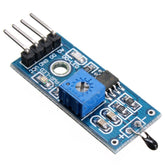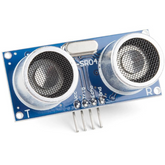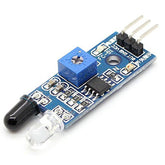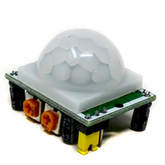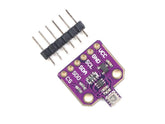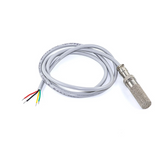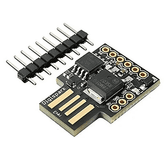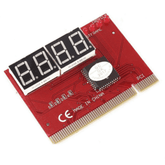Top 5 Sensors Every DIYer Should Own (And What You Can Build with Them)
Summary
If you've ever marveled at a smart thermostat adjusting the temperature on its own or a security light that flicks on when you walk by, you've seen a sensor in action.
These tiny electronic components are the eyes and ears of our gadgets, giving them the ability to perceive and react to the world around them.
For any DIY electronics enthusiast, learning to use sensors is like gaining a superpower, transforming static projects into dynamic, interactive creations.
This guide will introduce you to the world of Sensors in IoT and present a List of Sensors for IoT Projects that are essential for any maker's toolkit.

What Is a Sensor?
In the simplest terms, a sensor is a device that detects a change in its environment and sends that information to another electronic device, usually a computer processor. Think of them as the digital equivalent of our own five senses.
Just as your skin feels temperature changes and your eyes detect light, a sensor measures a physical property like heat, light, or motion. Once it detects this property, it converts the measurement into an electrical signal.
These devices are a specific class of transducers, which is a broader term for any device that converts one form of energy into another. A sensor specifically converts a physical phenomenon into an electrical signal.
There are hundreds of types of sensors, each designed to measure a specific physical quantity, from the pressure of the air to the chemical composition of a gas. For a DIYer, understanding how to harness these tiny components is the first step toward building truly "smart" devices.
How Sensors Work
At its core, every sensor operates on a simple principle: a physical interaction causes a measurable electrical change. The exact mechanism depends on the type of sensor, but the outcome is the same.
For example, a temperature sensor might contain a material whose electrical resistance changes predictably as it gets hotter or colder. A light sensor might generate a tiny electrical current when photons strike its surface.
This electrical change, whether it's a change in voltage, current, or resistance, is the sensor's output. However, this raw signal isn't very useful on its own. It needs to be read and interpreted by a microcontroller, like an Arduino, or a single-board computer, like a Raspberry Pi.
The microcontroller reads the analog voltage or digital signal from the sensor and, using a bit of code, translates it into a meaningful value. For instance, it might convert a 0.75-volt signal from a temperature sensor into a reading of 25°C.
Once the microcontroller has this data, it can be programmed to act on it—turning on a fan, sending an alert to your phone, or logging the data for a future project. This process is the foundation of countless electronics and IoT projects.
List of Top 5 Sensors for IoT Projects
This Sensor list covers the most versatile and beginner-friendly components that form the backbone of many DIY electronics. Each one is a powerful IoT sensor that can add a new dimension of awareness to your projects.
1. Temperature Sensors

A temperature sensor is one of the most fundamental IoT sensors you can have in your collection. These devices do exactly what their name implies: they measure ambient heat energy, allowing your projects to sense how hot or cold their environment is.
Working Principle
The most common temperature sensors for DIY projects, like the DHT11, DHT22, or LM35, work in a few different ways. The LM35 is an analog sensor that produces an output voltage directly proportional to the Celsius temperature.
For every degree Celsius, the output voltage increases by 10 millivolts. Other popular IoT sensors, such as the DHT11 and DHT22, are digital. They contain a thermistor—a resistor whose resistance changes significantly with temperature—and a small chip to convert that resistance reading into a digital signal that communicates both temperature and humidity data.
Types of Temperature Sensors
- Thermistors: These are resistors whose resistance changes dramatically with temperature. They are inexpensive and widely used but require calibration.
- Resistance Temperature Detectors (RTDs): These use a pure metal wire (like platinum) whose resistance increases linearly with temperature. They are very accurate and stable but more expensive.
- Thermocouples: These consist of two different metal wires joined at one end. When the junction is heated, it generates a small voltage. They can measure very high temperatures but require complex signal conditioning.
- Semiconductor-based Sensors (ICs): These are integrated circuits like the LM35 or DS18B20. They provide a direct, easy-to-read output (analog or digital) and are the most popular choice for DIY projects due to their simplicity.
Use Cases
The possibilities for temperature sensors are vast.
- Smart Thermostat: Build a device that reads the room temperature and automatically controls a fan or a small heater to maintain a set temperature.
- Weather Station: Combine it with other sensors to create a comprehensive weather station that logs temperature trends over time.
- Automated Greenhouse: Monitor the temperature inside a small greenhouse and activate a ventilation system if it gets too hot.
- Fridge/Freezer Alarm: Place a sensor inside your refrigerator and program an alarm to sound if the temperature rises above a certain threshold, indicating the door was left open.
2. Proximity Sensors

A proximity sensor is an IoT sensor that can detect the presence of nearby objects without any physical contact. This is the technology that allows a robot to avoid bumping into walls or a tap to turn on when you place your hands under it.
Working Principle
There are many Sensor types for proximity detection, but the most common for hobbyists are infrared (IR) and ultrasonic sensors. An IR proximity sensor works by emitting a beam of infrared light from an LED and then measuring the light that reflects off an object with a light detector.
The more light that returns, the closer the object. An ultrasonic sensor works similarly but uses sound waves instead of light. It emits a high-frequency sound pulse and measures the time it takes for the echo to return, calculating distance based on the speed of sound.
Types of Proximity Sensors
- Inductive Proximity Sensors: These detect only metallic objects by generating an electromagnetic field. When a metal object enters the field, it induces eddy currents, which change the field and trigger the sensor.
- Capacitive Proximity Sensors: These detect any object, metallic or non-metallic, by measuring changes in capacitance. They can even detect objects through non-conductive materials like plastic or glass.
- Ultrasonic Proximity Sensors: These use sound waves to measure distance and are excellent for detecting objects regardless of their color or material.
- Infrared (IR) Proximity Sensors: These use infrared light and are commonly found in DIY kits. They are cost-effective but can be affected by ambient light.
Use Cases
Proximity sensors are perfect for projects that require navigation or hands-free activation.
- Obstacle-Avoiding Robot: Mount an ultrasonic sensor on the front of a small robotic car to help it navigate a room without crashing.
- Automatic Hand Sanitizer Dispenser: Use an IR proximity sensor to detect a hand and trigger a small pump.
- Smart Trash Can: Create a bin that automatically opens its lid when you approach it.
- Garage Parking Assistant: Install an ultrasonic sensor at the front of your garage to signal when your car is parked at the perfect distance from the wall.
3. Infrared (IR) Sensors

While some proximity sensors use infrared technology, the term "IR sensor" in the DIY world often refers to an IR receiver. This specific IoT sensor is designed to detect and decode the infrared signals sent by common remote controls, like the one for your television.
Working Principle
An IR receiver, such as the popular TSOP4838, is tuned to a specific frequency of infrared light (usually 38 kHz). Remote controls work by flashing an IR LED in a specific coded pattern.
The IR receiver detects this flashing pattern and converts it into a digital signal that a microcontroller can decipher. Each button on your remote sends a unique code, allowing your project to know exactly which button was pressed.
Types of Infrared Sensors
- IR Receivers: These are the most common type for DIY projects. They are passive, meaning they only receive signals, and are designed to decode the modulated signals from remote controls.
- IR Transmitters (LEDs): These are the emitters found in remote controls. They can be used in projects to send signals to other devices.
- IR Proximity Sensors: These combine an IR LED and a detector to measure reflected light for object detection.
- Thermal IR Sensors (Pyroelectric): These detect infrared radiation emitted by warm objects, like the human body, and are the core component of PIR motion sensors.
Use Cases
This is one of the best IoT sensors for adding remote control functionality to any project.
- DIY Universal Remote: Program an Arduino to control various appliances like lights, fans, or blinds using any standard remote control.
- Media Center Control: Use an IR receiver with a Raspberry Pi to control your media player software (like Kodi) with a TV remote.
- Remote-Controlled Car: Build a simple vehicle that you can drive using the buttons on a spare remote.
- Secret Knock Lock: Create a system where a door only unlocks if you press a secret sequence of buttons on a remote.
4. Humidity Sensors

A humidity sensor, also known as a hygrometer, measures the amount of water vapor in the air, or the relative humidity. It's an incredibly useful IoT sensor for environmental monitoring, agriculture, and comfort control.
Working Principle
Most digital humidity sensors you'll find for DIY projects are capacitive. They consist of two electrodes with a moisture-holding substrate (a dielectric material) between them.
As the humidity in the air changes, the amount of moisture absorbed by the substrate also changes. This alters the dielectric constant of the material, which in turn changes the capacitance between the electrodes.
An onboard chip measures this capacitance and converts it into a humidity reading. Many popular types of sensors, like the DHT11 and DHT22, combine a humidity and temperature sensor into a single package.
Types of Humidity Sensors
- Capacitive Humidity Sensors: These are the most common type in modern electronic devices. They are accurate, stable, and relatively inexpensive.
- Resistive Humidity Sensors: These use a hygroscopic material whose electrical resistance changes with humidity. They are less common in DIY electronics.
- Thermal Conductivity Humidity Sensors: These measure humidity by comparing the thermal conductivity of dry air to that of moist air. They are typically used in industrial applications.
Use Cases
Humidity sensors are essential for projects that need to respond to atmospheric moisture levels.
- Automated Plant Watering System: Place a sensor near your houseplants and have it trigger a water pump only when the air becomes too dry.
- Smart Dehumidifier Control: Connect the sensor to a smart plug to automatically turn on a dehumidifier when the humidity in a basement exceeds a certain level.
- Weather Station: Add humidity readings to your DIY weather station for a more complete picture of local conditions.
- 3D Printer Filament Dry Box: Monitor the humidity inside a storage box for 3D printing filament to prevent it from absorbing moisture and becoming brittle.
5. Motion Sensors

A motion sensor is a cornerstone of home security and automation projects. This type of sensor is designed to detect movement, typically from a person or animal, within a specific area.
Working Principle
The most common motion sensor for DIYers is the Passive Infrared (PIR) sensor. The "passive" part is key—unlike an IR proximity sensor, it doesn't emit any energy of its own.
Instead, it's equipped with a special lens and a pyroelectric sensor that is sensitive to the infrared radiation (body heat) naturally emitted by warm-blooded creatures.
The sensor is split into two halves, and it triggers when it detects a rapid change in infrared energy as a warm body moves from one half's field of view to the other. These are some of the most widely used IoT sensors in smart homes.
Types of Motion Sensors
- Passive Infrared (PIR) Sensors: These are the most common and affordable type, ideal for detecting human and animal movement based on body heat.
- Microwave Sensors: These emit microwave pulses and detect the Doppler shift in the reflected waves. They are more sensitive and can detect movement through walls but are more expensive and can cause false alarms.
- Ultrasonic Motion Sensors: These work similarly to microwave sensors but use sound waves. They are often used in automatic doors.
- Dual-Technology Sensors: These combine two types, like PIR and microwave, to reduce false alarms. Both sensors must trigger for an alarm to sound.
Use Cases
PIR sensors are perfect for projects that should activate when someone enters an area.
- Home Security System: Program a PIR sensor to trigger a loud buzzer or send a notification to your phone when it detects motion while you're away.
- Automatic Lighting: Install a sensor in a hallway, closet, or bathroom to turn the lights on automatically when someone enters and turn them off after a period of inactivity.
- Wildlife Camera: Create a trail cam that uses a PIR sensor to trigger a camera to take a photo whenever an animal wanders by.
- Interactive Halloween Props: Build a spooky decoration that jumps out or makes a noise when an unsuspecting trick-or-treater walks past.
Conclusion
Sensors are the bridge between the digital and physical worlds. They empower your DIY electronics to see, hear, and feel, transforming them from simple circuits into intelligent, responsive systems.
The five sensors covered here—temperature, proximity, infrared, humidity, and motion—represent a versatile and affordable starting point for any aspiring maker.
By mastering this basic sensor list, you unlock a universe of creative possibilities. So grab an Arduino, pick a sensor, and start building something that interacts with the world in a whole new way.



